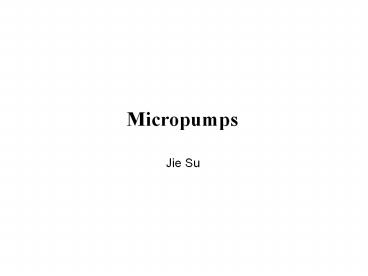Micropumps - PowerPoint PPT Presentation
Title:
Micropumps
Description:
Mechanic pump. Membrane pump. Diffuser pump. Non-Mechanic pump. Bubble pump. Electrohydrodynamic (EHD) pump. Summary. Introduction ... – PowerPoint PPT presentation
Number of Views:1627
Avg rating:3.0/5.0
Title: Micropumps
1
Micropumps
Jie Su
2
Outline
- Introduction
- Different types of micropumps
- Mechanic pump
- Membrane pump
- Diffuser pump
- Non-Mechanic pump
- Bubble pump
- Electrohydrodynamic (EHD) pump
- Summary
3
Introduction
- Micropumps play a significant role in
microfludical systems of MEMS. - Micropumps were started in middle 1980s.
- Before 1990s, mechanical pumps were mainly
studied. After 1990s, non-mechanical pumps were
introduced. - Presently most micropumps aim to fluid pumping.
4
Mechanical Pump
- In general, mechanical pump consists of moveable
components, such as moveable valves, moveable
membrane, moveable channel, etc. - Mechanical pump can be categorized into
- Membrane pump
- Rotary pump
- Diffuser pump
5
Membrane Pump
- Membrane Pump often consists of two check valves
and a chamber with moveable membrane. - By some mechanisms, membrane can be actuated to
change the volume of chamber. - Because the check valve can be opened only in one
direction, for each circle, some fluid will be
moved from inlet to outlet.
6
Electrostatic Membrane Pump
- Goodness
- Low power, good control of actuation and short
response time. - Weakness
- High actuation voltage, small stroke.
R. Zengerle et. al., MEMS95
7
Pieozelectric Membrane Pump
- Goodness
- Large actuation force, and short response time.
- Weakness
- Low working frequency, small stroke.
V. Lintel et al., Sensors and Actuators A, 1988,
15p. 153-167
8
Thermopneumatic Membrane Pump
- Goodness
- Large actuation force, low operating voltage.
- Weakness
- Low driving frequency
Lammerink, 1993 Lammerink, 1996
9
Shape Memory Alloy Driven Membrane Pump
Suction State
Pumping State
- Goodness Large pumping rate, high working
pressure. - Weakness Low driving frequency, low energy
efficiency
W.L., Benard, et. al., A Titanium-Nickel
Shape-Memory Alloy Actuated Micropump,
Proceedings of Transducers97, vol. 1, pp.361-364
10
Rotary Pump
- Magnetically driven
- Magnetic stator and central pin are permalloy
- Rotors were separately made and assembled into
pump by hand (50 microns tall, 500 microns
diameter). - Problems are the complex fabrication process and
reliability.
C.H. Ahn and M.G. Allen, Fluid Micropumps Based
on Rotary Magnetic Actuators, MEMSs 95, 1995,
pp. 408-412
11
Diffuser Pump
- Difference between diffuser pump and membrane
pump is that diffuser pump has no check valves.
Instead, two diffusers are introduced. - Diffuser is a channel with a increasing cross
sectional area. When fluid flows in one way or
the other, it will encounter different flow
resistances caused by the diffuser.
12
Diffuser Pump
- Except the difference between diffusers and
valves, diffuser pump is similar with membrane
pump. - Many mechanisms can be used to drive a diffuser
pump. - Goodness simple fabrication, free of valve
fatigue. - Weakness sensitive to bubbles, low operating
pressure
Stemme et al., 1993,
13
Non-Mechanical Pump
- Without movable parts, non-mechanical pump is
often much simpler than mechanical pump. - Non-mechanical pump includes
- EHD pump
- Bubble pump
- Other pumps
14
EHD Pump
- EHD pump uses applied electric field to induce
and drag charges in fluid. - Goodness no moving parts, very simple
fabrication process - Weakness unsuitable for conductive fluid
15
A Planar EHD Pump
Si-Hong Ahn, Yong-Kweon Kim, Fabrication and
experiment of a planar micro ion drag pump,
Sensors and Actuators A70 (1998) 1-5
16
Our Design of EHD Pump
- Build the electrodes and channel on the same
wafer. - Electrodes go across the sidewall, resulting in a
higher efficiency.
17
Two Successive Pumping Photos
Fluid
Fluid
18
Simplest Pump Bubble Pump
- Goodness simple
- Weakness low flow rate, and fluid will be
overheated near the heater.
T.K. Jun and C.-K. kim, J. Appl. Phys., Vol. 83,
No. 11, 1998
19
Bubble Pump
T.K. Jun and C.-K. kim, J. Appl. Phys., Vol. 83,
No. 11, 1998
20
Summary
- Many kinds of micropump are fabricated
- No perfect micropump exists. Each micropump has
its weakness and goodness. - More work need to be done.































